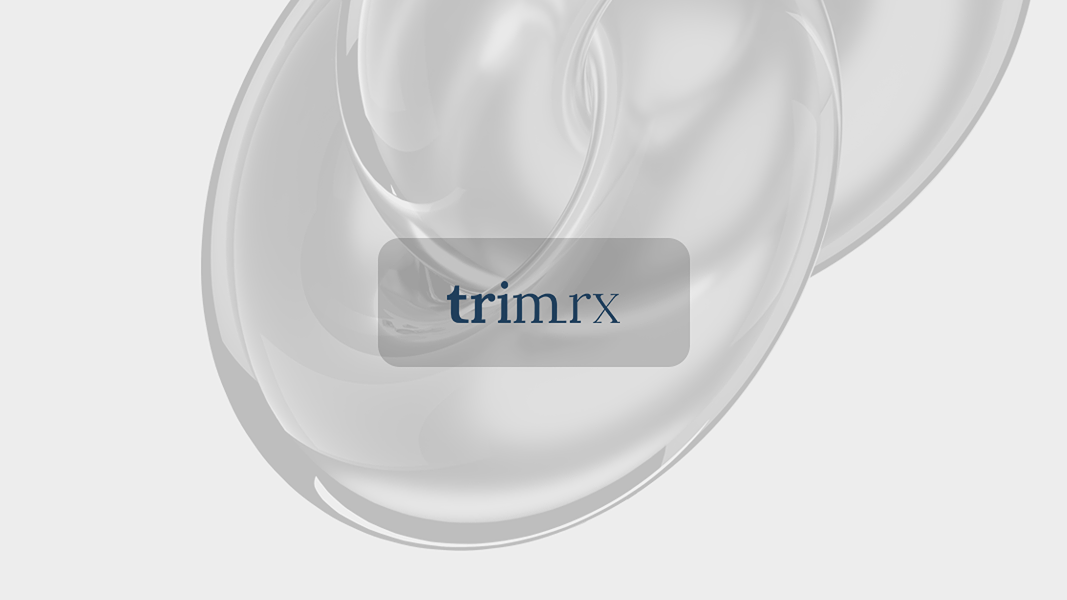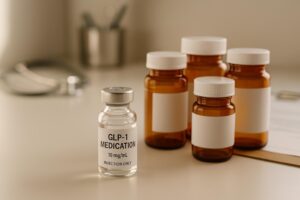Understanding Why GLP-1 Medications Cause Nausea

Introduction
Have you ever considered how your body reacts when introducing a powerful medication designed to change your metabolism and appetite? It’s a complex dance of hormones, receptors, and neurological signals. GLP-1 medications, such as Ozempic® and Wegovy®, are revolutionizing the way we manage weight and diabetes by mimicking the GLP-1 hormone, which plays a pivotal role in appetite regulation. However, these medications often bring along nausea as a common side effect, especially during the initial phases of treatment.
Understanding the connection between GLP-1 medications and nausea is crucial for anyone considering or currently using these drugs. It sheds light on how these medications work within our bodies and why nausea occurs. Moreover, by grasping the underlying mechanisms, we can better manage this side effect and continue on the path to sustainable weight loss.
In this post, we will cover the following topics:
- An overview of GLP-1 medications and how they function.
- The biological mechanisms that lead to nausea.
- Why nausea can be a sign that the medication is working.
- Strategies to alleviate nausea while on GLP-1 medications.
- The importance of communication with healthcare providers.
By the end of this article, you will have a comprehensive understanding of why GLP-1 medications cause nausea and how to effectively manage it, ensuring your journey towards a healthier you is as smooth as possible.
Nausea is often an uncomfortable companion on the journey of weight loss, especially for those taking glucagon-like peptide-1 (GLP-1) medications. If you’ve recently embarked on a path to healthier living and found yourself battling this common side effect, you’re certainly not alone. Research indicates that as many as 30-40% of patients taking GLP-1 medications experience nausea at some point during their treatment. This statistic highlights how prevalent this issue is for individuals striving for weight loss through these innovative therapies.
At TrimRx, we believe in providing not just effective weight loss solutions but also the knowledge to navigate the journey with confidence. In this blog post, we will explore why GLP-1 medications cause nausea, the mechanisms behind this side effect, and practical strategies to manage it effectively.
Overview of GLP-1 Medications
GLP-1 medications are a class of drugs primarily used to treat type 2 diabetes and, more recently, obesity. They mimic the effects of the naturally occurring hormone GLP-1, which is secreted by the intestines in response to food intake. Here’s a deeper look at how these medications function:
How GLP-1 Medications Work
- Appetite Regulation: GLP-1 medications enhance feelings of fullness, reducing the desire to eat. They signal the brain to decrease appetite and increase satiety.
- Gastric Emptying: These medications slow down gastric emptying, meaning food stays in the stomach longer, which can prolong the sensation of fullness. While this is beneficial for appetite control, it can also contribute to feelings of nausea.
- Insulin Secretion: GLP-1 medications stimulate insulin release from the pancreas in response to meals, helping to lower blood sugar levels effectively.
- Glucagon Suppression: They inhibit the release of glucagon, a hormone that increases blood sugar levels, further aiding in blood sugar control.
These multi-faceted actions make GLP-1 medications a powerful tool in managing weight and diabetes. However, the mechanism that slows gastric emptying can also lead to gastrointestinal discomfort, including nausea.
The Biological Mechanisms Behind Nausea
Nausea is a complex response that can arise from several interactions within the body. Here’s a breakdown of how GLP-1 medications contribute to this sensation:
1. Gastric Emptying Delay
As mentioned, GLP-1 medications slow gastric emptying, which can lead to feelings of fullness and, consequently, nausea. When food remains in the stomach longer than usual, it can trigger discomfort and the urge to vomit.
2. Neuronal Activation
Recent research has identified specific neurons in the brain, particularly in regions like the area postrema and nucleus tractus solitarius, that respond to GLP-1. Activation of these neurons can lead to nausea, as they are involved in processing signals related to both satiety and aversion.
3. Impacts on the Gut-Brain Axis
The gut and brain communicate through a complex network known as the gut-brain axis. GLP-1 medications alter gut hormone levels, which can send signals to the brain that are interpreted as nausea.
4. Individual Variability
Each person’s body responds differently to medications, influenced by factors such as genetics, diet, and overall health. This variability can contribute to the severity of nausea experienced.
Understanding these mechanisms can help demystify why nausea occurs with GLP-1 medications and why it can be a sign that the medication is taking effect.
Why Nausea Can Be a Positive Sign
While nausea is often an unwelcome companion, it can also signal that the medication is working as intended. Here’s why some level of nausea might not be all bad:
1. Appetite Suppression
Mild nausea can indicate that the medication is effectively suppressing your appetite, a key factor in weight loss. For many, the ability to feel less hungry is a crucial step toward achieving and maintaining weight loss goals.
2. Adjustment Period
Nausea is typically more pronounced in the initial stages of treatment or when dosages are increased. This discomfort often decreases as the body adjusts to the medication. Recognizing this can provide reassurance during the adjustment phase.
3. Mindful Eating
Experiencing nausea can lead to more conscious eating habits. Individuals might become more attuned to their hunger cues and make healthier food choices, further supporting their weight loss journey.
Strategies to Manage Nausea
If you find yourself struggling with nausea while on GLP-1 medications, there are several strategies to ease this side effect:
1. Start Slow
When beginning treatment, starting at a lower dose and gradually increasing it can help minimize gastrointestinal side effects, including nausea. This allows your body time to adjust to the medication.
2. Eat Smaller, Frequent Meals
Large meals can overwhelm the digestive system, exacerbating nausea. Instead, we recommend consuming smaller meals throughout the day to help manage your appetite and minimize discomfort.
3. Choose Bland Foods
Opt for bland, low-fat foods that are easier on the stomach, such as toast, rice, and bananas. Avoid greasy, spicy, or strongly flavored foods that can trigger nausea.
4. Stay Hydrated
Keeping hydrated is essential, but be cautious not to drink large amounts at once, which can worsen nausea. Sip on water or ginger tea throughout the day to help settle your stomach.
5. Incorporate Protein
Protein can help stabilize blood sugar levels and keep you feeling full. Including protein-rich foods in your diet can mitigate some nausea while also supporting your overall health.
6. Avoid Strong Smells
Strong odors can trigger nausea for many individuals. Cold foods often have less odor and can be more tolerable. Consider meals that are served cold or at room temperature.
7. Medication Support
In some cases, anti-nausea medications may be beneficial. Don’t hesitate to discuss this option with your healthcare provider if nausea becomes severe or persistent.
8. Communicate with Your Healthcare Provider
Open communication with your healthcare provider is key. If nausea is significantly impacting your daily life, it may be necessary to adjust your dosage or explore alternative treatments.
Conclusion
Nausea is a common side effect of GLP-1 medications, but it’s also a sign that the medication is affecting your body in the intended way. Understanding the mechanisms behind this side effect can empower you to manage it effectively. By implementing practical strategies, you can minimize nausea and stay focused on your weight loss journey.
At TrimRx, we are committed to supporting you every step of the way. Our personalized weight loss programs combine medically supervised care with innovative weight loss solutions. If you’re interested in exploring whether GLP-1 medications are right for you, we encourage you to take our free assessment quiz. Your journey towards a healthier lifestyle can begin today with the right support.
FAQ
Is nausea a common side effect of GLP-1 medications?
Yes, nausea affects approximately 30-40% of patients taking GLP-1 medications, especially during the initial stages of treatment or with dosage increases.
Why does GLP-1 cause nausea?
Nausea is primarily caused by the delayed gastric emptying effect of GLP-1 medications, as well as the activation of certain neurons in the brain that process aversive signals.
How can I manage nausea while on GLP-1 medications?
Strategies include starting with a lower dose, eating smaller meals, choosing bland foods, staying hydrated, and communicating with your healthcare provider about your symptoms.
Does nausea mean the medication is working?
Mild nausea can indicate that the medication is suppressing appetite and having the desired effects on your body.
What should I do if nausea becomes severe?
If nausea significantly impacts your daily life, consult your healthcare provider to discuss potential adjustments to your medication or consider anti-nausea treatments.
We hope this guide has provided valuable insights into why GLP-1 medications can cause nausea and how to navigate this common side effect effectively. Remember, you are not alone on this journey, and together, we can achieve your weight loss goals.

Transforming Lives, One Step at a Time
Keep reading
Ultimate Guide to Semaglutide Dose Customization
This guide explores semaglutide dosing for diabetes and weight loss, emphasizing personalized adjustments for optimal results.
6 Common Drug Interactions with GLP-1 Medications
Learn about six common drug interactions with GLP-1 medications and how to manage potential risks for safe treatment.
Mounjaro Insurance Coverage: What to Know
Learn how insurance coverage for Mounjaro varies based on diabetes treatment and weight loss, along with tips for approval and cost-saving options.
Semaglutide vs. Tirzepatide: Max Dose
Explore the differences between two weight loss medications, their maximum doses, effectiveness, and safety profiles for better health outcomes.
GLP-1 Diet Plan: 7-Day Meal Guide
Learn how to effectively pair GLP-1 medications with nutritious meal planning for weight loss, improved digestion, and stable blood sugar.
Nausea and GLP-1 Medications: Solutions That Work
Learn effective strategies to manage nausea from GLP-1 medications, including dietary tips and the importance of personalized dosing.
5 Signs GLP-1 Medication Is Working for You
Learn the key signs that indicate your GLP-1 medication is effectively aiding weight loss, appetite control, and blood sugar management.
Plateau Problems: Restarting Weight Loss
Stalled weight loss on GLP-1 medications is common but manageable. Explore strategies to break through plateaus and regain momentum.
Body Fat Percentage Estimator – Know Your Stats
Estimate your body fat percentage in seconds with our free tool. Just input your height, weight, and more for instant results. Try it now!









